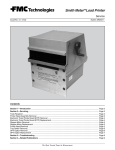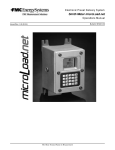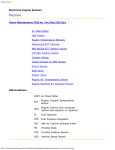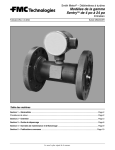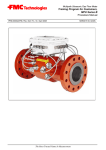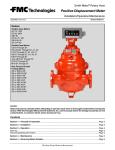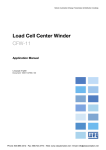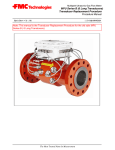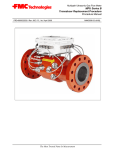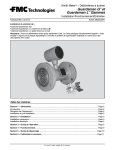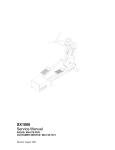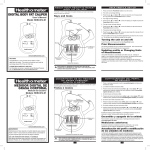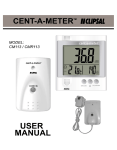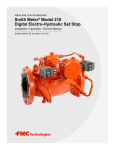Download MN03005
Transcript
Smith MeterTM Valves Set Stop Model 296 Installation/Operation Issue/Rev. 0.3 (1/03) Bulletin MN03005 Contents Section 1 — General .................................................................................................................................. Page 2 Section 2 — Dimensions ........................................................................................................................... Page 3 Section 3 — Specifications ....................................................................................................................... Page 4 Section 4 — Operation ............................................................................................................................... Page 5 Section 5 — Troubleshooting Guide ........................................................................................................ Page 10 Section 6 — Related Publications ............................................................................................................ Page 11 Issue/Rev. 0.3 (1/03) The Most Trusted Name In Measurement MN03005 • Page 1 Section 1 — General This manual has been prepared to acquaint the installer and serviceman with the operation, adjustment, and maintenance of the basic Smith MeterTM Model 296 Set Stop, Two-Stage Closure Valves, designed for adaptation of low flow start with a time delay relay. These set stop valves are designed to function with low viscosity products and to operate in conjunction with Smith meters equipped with set stop counters. The counter provides a means, by solenoid control, of reducing flow gradually through the valve, then shutting off accurately after a predetermined quantity of liquid has passed through the meter. There is no mechanical linkage between counter and valve. Remote electrical operation, such as interlocks and overfill detection, is also made possible with positive control and safety. In addition to the basic controls which are incorporated with these valves, certain additional control functions and accessories may be added as required for the application. Page 2 • MN03005 The Model 296 Valve is recommended for those installations requiring exact (±0.25 gallon) shut-off delivery of a determined quantity with a minimum of line shock and low flow start. These valves, except for the shape of the valve body, are identical in general design, application, and performance. For this reason, except where noted, the valves are treated as one in this manual. All illustrations are of the 4" Model 296 Valve unless otherwise indicated. Additional information will accompany this manual when accessories have been added to the basic valve. These products have been designed for petroleum applications, where corrosion/erosion is normally minimum. The design of the pressure containing housings have adequate material allowance for typical petroleum applications. Consult the factory for other applications or for the actual material allowances. Issue/Rev. 0.3 (1/03) Section 2 — Dimensions Model 296 Valve (Globe Pattern) Note: All dimensions shown are in inches. Size 3 4 6 A* B 11 3 13.50 3.38 17 5.12 C 5 6.31 Model 296 Valve C1 D E F G G1 8 14.25 10 9.19 0.25 1.50 8.88 16.38 10.75 10 0.25 1.50 G2 7 7.75 8 10.62 19.50 12.50 11.75 0.25 1.50 9.50 *Class 150 ASME Flanges. Issue/Rev. 0.3 (1/03) MN03005 • Page 3 Section 3 — Specifications Sizes 3", 4", and 6": 296 Series Globe Pattern (cast steel). End Details Class 150 ASME B16.5 flanges (cast steel) Working Pressures Maximum Working Pressure: 150 psi. Note:The maximum working pressure is limited by the maximum operating pressure differential rating of the solenoid, not the system. Viscosity Maximum Viscosity at Flowing Temperature: 1,000 SSU (220 centistokes). Elastomer/Valve Temperature Limits1 LS (Low Swell) Buna: -20°F to 200°F (-29°C to 93°C). Buna-N Elastomers: -20°F to 200°F (-29°C to 93°C). Viton Elastomers: -20°F to 350°F (-29°C to 177°C). Materials Main Body and Cover: Cast Steel. Internals: Ductile iron, bronze, and stainless steel. Pilots and Control Loop: Steel controls/steel tubing. Electrical Ratings 120, 240, 480 Vac 60 Hz or 110, 200, 440 Vac 50 Hz. Optional Equipment Available Junction Box, Low Flow Start Timer, Rate of Flow Control, Pressure Reducing Control, Back Pressure Control, others (consult factory or nearest sales office). Strainer Diaphragm Type Valve (2 to 6 inch): 1. Valves with a Low Swell Buna, Viton or Buna-N diaphragms and seals: It is recommended that a 4 mesh or finer strainer be installed upstream of the valve to ensure minimum maintenance and maximum service life. Note: Before starting up a new installation or any system which has been contaminated with foreign materials (from repairs, damaged equipment, etc), it is strongly recommended that the following be done: 1.Clean the foreign materials from the line, especially between the strainer and valve. 2.Install a temporary fine mesh screen (40 mesh or finer) in the strainer, in order to remove the remaining foreign materials from the system. Pressure Loss Graphs It should be noted that these pressure losses are for full open valves and cannot be used when considering modulating valves, since they rarely go full open during normal operation. These pressure losses can, however, be used as guidelines for proper valve sizing. 200 and 200PC Series Pressure Loss 1200 and 1200PC Series Pressure Loss Flow Data: Valve in wide open position. Valve cover vented to atmosphere. Specific gravity 1.0 (water at 60°F). 1 Temperature Limits are based on the following: (a) minimum temperature rating of the housing, (b) min./max. effective temperature of one of the seals, (c) min/max. temperature limit of typical applications. Page 4 • MN03005 Issue/Rev. 0.3 (1/03) Section 4 — Operation The Model 296 basic Set Stop Valve is complete with all accessories and controls necessary to provide automatic two-stage shutdown for a typical loading operation when used in conjunction with a two-stage set stop counter or similar device. The valve is designed to operate in conjunction with a Model 15A Low Flow Start Timer, a Model 40 Rate of Flow Control, a Model 50A Pressure Reducing Control, a Model 60A Back Pressure Control, and others (consult factory). It is recommended that at least one (1) modulating pilot (such as a rate of flow control) be used to keep the valve in a modulating condition at all times. This assures the necessary emergency shutdown response time, thereby minimizing accidental overruns. This manual’s principles of operation are based on the 296-40. The Model 296 basic Set Stop Valve is designed to accomplish the following basic functions: 1. Adequately control the flow to affect an accurate zero shutoff, without excessive line shock, by utilizing a two-stage shutdown. 2. Limit the flow rate to the meter’s maximum rating by adding the rate of flow pilot (40A), thus avoiding meter damage. 3. Limit the downstream pressure by adding the pressure reducing pilot (50A), thus protecting the truck manifold (bottom loading). 4. Limit the overrun to a safe quantity, guarding against spills if the emergency shutdown has to be actuated. The graph, shown below, is a typical loading operation curve representing the sequence of operation for the 296 Set Stop Valve. Each major control component on the 296 valve is listed down the left side of the chart. The loading operation curve is divided into 8 zones from left to right. This will allow a breakdown of the principle of operation into 8 separate zones. Note that the text and examples are based on including the Low Flow Start Timer. The heavy dark lines indicate energized circuits in the electrical schematics and high-pressure circuits in the hydraulic schematics. Dotted lines indicate inter- mediate pressure in the hydraulic schematics. Installation Note: Entrapped air in the valve cover and/ or control loop can cause the valve to function erratically and cause severe shocks. Therefore, the air must be vented from the valve cover and/or the highest point in the control loop. Open the gate valve only slightly so that the entire meter run (including the motor and valve) can slowly fill up with product while the air is vented. Zone No. 1 - Valve Closed Start-Up Procedure With the set stop counter in the “off” position and the set stop counter switches A and B open, the solenoids are de-energized, pressurizing the valve cover and holding the valve fully closed. The closing speed control should initially be opened one (1) turn, thus assuring that the valve will close quickly under emergency conditions. Fine-tuning of this control must be done later, as described in Zone No. 5. The opening speed control should initially be opened to 1/ 2 turn, thus assuring slow opening of the valve, help- ing to eliminate any severe surprises. Fine-tuning of this control will be done later, as described in Zone No. 4. The rate of flow control has been adjusted at the factory for the flow rate specified on the log sheet, based on customer specification or maximum rating of meter if known. Therefore, adjustment at this time is not normally required. Fine-tuning of this control will be described in Zone No. 5. The low flow start timer coil wire should be disconnected so that all the Zone No. 3 adjustments can be made without the interference from the timer. Issue/Rev. 0.3 (1/03) MN03005 • Page 5 Section 4 — Operation (continued) Zone 1 — Valve Closed (Model 296-40) Zone No. 2 - Transition from Valve Closed to Low Flow Condition CAUTION Until the valve is completely under control and functioning correctly, the system should be operated with only a partially opened butterfly or gate valve upstream of the meter run. This upstream valve should be opened only enough to allow the necessary flow rate for the adjustments being made. Only when the valve has been cycled through the entire sequence, should the upstream butterfly or gate valve be fully opened. Pull out the set stop counter knob which closes the set stop counter switches A and B. This energizes both solenoids and the low flow start timer coil (now temporarily disconnected), shutting off the upstream supply of pressure to the valve cover and draining the valve cover downstream through the opening speed control, the rate of flow control, and the normally closed solenoid pilot valves. The opening speed control adjustment could be made at this time if it is required; however, it is recommended that the fine-tuning be done in Zone No. 4 after observing an entire valve sequence of operation. Zone 2 — Transition from Closed to Low Flow Condition (Model 296-40) Zone No. 3 - Low Flow Condition When the main valve opens far enough, the stem switch is actuated, de-energizing the normally closed solenoid and causing the valve to become hydraulically locked. The valve cannot open or close at this point. The stem switch cam should be adjusted to allow the desired flow rate for the low flow condition. This is achieved by loosening the nuts on the threaded stem, Page 6 • MN03005 located on the top of the valve cover, and moving the cam up or down. Moving the cam up will cause a lower flow rate. Moving the cam down will cause a higher flow rate. Before the low flow start timer coil is reconnected, push the emergency button on the set stop counter, which should cause the valve to close. This will prove the valve can be closed and opened. If the system is a high Issue/Rev. 0.3 (1/03) Section 4 — Operation (continued) pressure system, it may be necessary to readjust the closing speed control in order to reduce the line shock. If the closing speed control is readjusted, repeat Zone Nos. 2 and 3. If everything seems to be operating correctly, reconnect the low flow start timer coil and adjust the desired low flow time duration. Zone 3 — Low Flow Condition (Model 296-40) Zone No. 4 - Transition from Low Flow Condition to High Flow Condition When the low flow timer times out, the actuated timer contacts energize the normally closed solenoid and deenergizes the normally open solenoid. This allows the valve to open to the high flow condition, at which point the rate of flow control should start modulating the valve near the specified flow rate setting. The opening speed control should be fine tuned at this point to achieve a smooth transition. If a change in adjustment is made, push the emergency button and repeat Zone Nos. 2 through 4 for a final opening speed observation. Zone 4 — Transition from Low Flow Condition to High Flow Condition Zone No. 5 - High Flow Condition When the flow rate approaches the specified limit, the rate of flow control should sense the differential pressure, proportional to the flow, developed across the orifice plate, located in the valve flange. This differential pressure causes the rate of flow control pilot to start closing, causing a pressure to build up in the cover of Issue/Rev. 0.3 (1/03) the valve, forcing the main valve to modulate (or control) flow rate. A hydraulic balance is then reached, preventing excessive flow rates. The closing speed control must be adjusted first because this adjustment affects the setting of the rate of flow control. MN03005 • Page 7 Section 4 — Operation (continued) The closing speed control must be adjusted during an emergency shutdown. This control must be adjusted to limit the number of gallons throughput after the high-level detector signals an emergency shutdown in order to prevent a spill and, at the same time, prevent excessive line shock. A typical maximum permissible throughput after an emergency shutdown signal is 18 to 20 gallons. The rate of flow control should be adjusted after the closing speed control has been set. It should be fine tuned to allow the desired specified high flow rate. By turning the adjustment screw clockwise, the flow rate will increase. By turning the adjusting screw counter-clockwise, the flow rate will decrease. If adjusting screw reaches its stop in either direction before desired flow rate is obtained, resizing of the orifice plate may be necessary or, desired flow rate is beyond system capability. Zone 5 — High Flow Condition (Modulating Condition Should Exist) (Model 296-40) Zone No. 6 - Transition from High Flow Condition to Low Flow Condition When the set stop counter counts down and actuates the first stage trip point, the set stop counter switch A opens, de-energizing the normally closed solenoid and pressurizing the cover of the valve, which initiates the main valve to close. The speed at which the valve reaches 2nd stage flow is governed by the adjustment made previously for emergency shutdown and should not be changed for this function of the operation sequence. Zone 6 — Transition from High to Low Flow Condition (Model 296-40) Page 8 • MN03005 Issue/Rev. 0.3 (1/03) Section 4 — Operation (continued) Zone No. 7 - Low Flow Condition When the valve reaches the low flow position, the stem switch is again actuated, closing the switch contact. This energizes the normally open solenoid and locks the main valve hydraulically. A few trials may be necessary if the precise low flow rate is required. The low flow rate should be approximately the same flow rate as was set for the low flow start feature in Zone No. 3 and cannot be changed without also changing the low flow start flow rate. (Refer to Zone No. 3 for stem switch adjustment.) Zone 7 — Low Flow Condition (Model 296-40) Zone No. 8 - Transition from Low Flow Condition to Valve Closed When the set stop counter actuates the final stage trip point, the set stop counter switch B opens. This de-energizes the normally open solenoid and timer coil, fully closes the main valve, and resets the timer contacts for the next loading operation. To obtain an accurate zero shutoff, the set stop counter cam for the final stage trip point may have to be adjusted. For this adjustment, refer to the Installation/Operation/ Service Manual for the set stop counter, Bulletin MN01012. Zone 8 — Transition from Low Flow to Valve Closed (Model 296-40) Issue/Rev. 0.3 (1/03) MN03005 • Page 9 Section 5 — Troubleshooting Guide Problem Valve does not open. (No pressure registers at inlet side of valve.) Valve does not open. (Pressure registers at inlet side of valve.) Main valve bypasses low flow start or low flow shutdown. Main valve functions erratically and causes severe shocks. Main valve opens too fast or too slow. Valve does not go into 1st stage slow down prior to shutdown. Product flow decreases too fast during emergency stop. Desired high flow rate is unobtainable by adjusting 40A rate of flow pilot. Valve does not enter 2nd stage of final shutdown. Valve does not shut off at zero. Page 10 • MN03005 Cause Upstream shutoff valve is closed. Obstruction in upstream shutoff valve. Pump not operating. Downstream shutoff valve is closed. Differential pressure across valve is too low (below 5 psi). Needle valves not adjusted properly. Obstruction in pilot or main diaphragm is ruptured. No electric power. Set stop counter switches not functioning. Stem switch not operating properly. Low flow start timer adjusted to zero timer. Entrapped air in the valve control loop. Opening speed needle valve out of adjustment. Set stop counter handle does not function properly. 1st trip set stop switch A out of adjustment or defective. 1st trip N.C. solenoid defective. Closing speed control is open too wide. Desired flow rate is then beyond system capability, or resizing of orifice may be necessary. Set stop counter not functioning properly. N.C. solenoid does not open. 2nd trip set stop switch B out of adjustment or defective. Low flow rate too fast or too slow. Stem switch out of adjustment. Set stop counter trip cam out of adjustment. Remedy Open shutoff valve. Remove obstruction. Start pump. Open shutoff valve. Check pressure source for sufficient pressure. Opening speed control valve should be open. Adjust sensitivity needle valve (could be open too far). 1. Close the closing speed needle valves. 2. Slowly crack a fifting between closing speed control and valve cover in cover loop. 3. If valve opens, diaphragm is not ruptured. 4. If continuous flow through fiftings develop, then diaphragm is ruptured. 5. Close upstream gate valve and remove main valve cover and replace diaphragm. Check wiring and power source. Check set stop counter switches for electrical operation and adjustment. Check for proper functioning of switch. Refer to Zone No. 3 - Stem Switch Adjustment. Adjust timer delay time. Refer to Zone No. 1, installation note. Turn adjusting stern on needle valve in clockwise direction to decrease opening speed. Refer to Set Stop Counter Bulletin. Refer to Set Stop Counter Bulletin for adjustment. Check for electrical operation. Replace coil if necessary. Turn adjusting stem clockwise to decrease rate of response. Consult factory or representative. Refer to Set Stop Counter Bulletin. Check timer. Solenoid should open. Replacement of solenoid may be necessary. Refer to Set Stop Counter Bulletin. Refer to Zone No. 3 for adjustment. Refer to Set Stop Counter Bulletin. Issue/Rev. 0.3 (1/03) Section 6 — Related Publications The following literature can be obtained from FMC Technologies Measurement Solutions, Inc. Literature Fulfillment at [email protected] or online at www.fmctechnologies.com/measurementsolutions. When requesting literature from Literature Fulfillment, please reference the appropriate bulletin number and title. Parts List (Form No.)* 2" ...................................................................................................................................................................... P1051 3" ...................................................................................................................................................................... P1052 4" ...................................................................................................................................................................... P1053 6" ...................................................................................................................................................................... P1054 *The latest edition is indicated by a 2-digit postscript (e.g., 01, 02, etc.) Issue/Rev. 0.3 (1/03) MN03005 • Page 11 Revisions included in MN03005 Issue/Rev. 0.3 (1/03): Page 2: Added corrosion/erosion note. Page 4: Removed cast iron option on 3" and 4" sizes. Changed end details from ANSI to ASME. Changed working pressure to 150 psi only. Modified note to specify differential pressure. Changed temperature ranges, added elastomer LS Buna and footnote 1 and 2. The specifications contained herein are subject to change without notice and any user of said specifications should verify from the manufacturer that the specifications are currently in effect. Otherwise, the manufacturer assumes no responsibility for the use of specifications which may have been changed and are no longer in effect. Headquarters: 1803 Gears Road, Houston, TX 77067 USA, Phone: 281/260-2190, Fax: 281/260-2191 Gas Measurement Products: Erie, PA USA Phone 814/898-5000 Thetford, England Phone (44) 1842-82-2900 Kongsberg, Norway Phone (47) 32/286-700 Buenos Aires, Argentina Phone 54 (11) 4312-4736 Integrated Measurement Systems: Corpus Christi, TX USA Phone 361/289-3400 Kongsberg, Norway Phone (47) 32/286-700 San Juan, Puerto Rico Phone 787/274-3760 United Arab Emirates, Dubai Phone 971 +4/331-3646 Liquid Measurement Products: Erie, PA USA Phone 814/898-5000 Los Angeles, CA USA Phone 661/702-8660 Slough, England Phone (44) 1753-57-1515 Ellerbek, Germany Phone (49) 4101-3040 Barcelona, Spain Phone (34) 93/201-0989 Moscow, Russia Phone (7) 495/564-8705 Melbourne, Australia Phone (61) 3/9807-2818 Beijing, China Phone (86) 10/6500-2251 Singapore Phone (65) 6861-3011 Chennai, India Phone (91) 44/450-4400 Visit our website at www.fmctechnologies.com Printed in U.S.A. © 1/00 FMC Technologies Measurement Solutions, Inc. All rights reserved. MN03005 Issue/Rev. 0.3 (1/03) Page 12 • MN03005 Issue/Rev. 0.3 (1/03)












